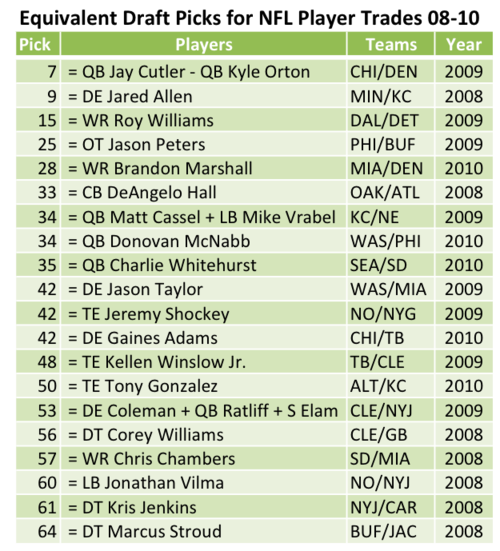
With the draft just a day away, fans are discussing trade scenarios constantly. Could the Eagles move up the draft to nab that one special player? Or would they move back? What would they have to give up? What kind of return could a trade for Kevin Kolb return?
Unfortunately, barring some last minute deal to start the new league year and end the lockout (despite Judge Nelson’s latest ruling), the Eagles will not be able to trade Kolb for more draft picks. Nor will any other team be able to trade players.
Yet when Kolb and others (such as old Philly friend Donovan McNabb) finally get traded, they will likely be dealt for future draft picks rather than other players. With these trades, the question becomes: how can we quantify the value of NFL players on the trading block?
With pick-for-pick trades, the rule of thumb is the “trade value chart,” which assigns a set number of points to each draft choice. For example, the number one overall pick is worth 3,000 points. In order for another team to trade up for that pick, they’d need a package of picks worth about the same total value. So, why not use the trade value chart to help us determine the trade value of veteran players and, in doing so, better estimate the potential return on any hypothetical trade involving a player like Kolb?
That was my task as I sorted through the last three years of NFL trades involving players and draft picks. I added up the total value of the picks and subtracted one round’s worth of value from each future pick, thus determining the equivalent draft pick that the player(s) involved in the deal were worth.
 At right you can see a list of all NFL players who were traded in the last three years for the equivalent of at least a second round pick. There are some interesting trades in there.
At right you can see a list of all NFL players who were traded in the last three years for the equivalent of at least a second round pick. There are some interesting trades in there.
The highest pick value traded was equivalent to the seventh overall selection: sent by Chicago to Denver in exchange for “the difference between” Jay Cutler and Kyle Orton. Obviously the Bears thought that gap was huge, and more valuable than any single player traded in the last three seasons. Next up is Jared Allen, traded for the equivalent of the ninth overall pick, and then Roy Williams (15th), in Jerry Jones’s debacle of a deal. The Eagles’ trade for Jason Peters valued the offensive tackle as a late first rounder; same with Miami’s acquisition of Brandon Marshall. All of these players were, at least in theory, expected to be stars.
There’s also an interesting “run” on quarterbacks worth the equivalent of a top second round pick. All three players are different — McNabb was the aging but productive veteran, Matt Cassell had played only one full season, and Charlie Whitehurst had never even started a game — yet essentially all three were valued equally.
What does this say about Kevin Kolb’s trade potential?
Last year, trade offers for Kolb were rumored to exceed those for McNabb, and one would expect that his production warrants a healthy bonus over a completely unproven quarterback like Whitehurst. At the same time, all the players worth first round compensation since 2008 were established Pro Bowlers before getting traded. Kolb doesn’t fit that profile as a “sure-thing” star, but it’s likely that the barren quarterback market will boost his price into the mid-to-late first round.
Originally published at NBC Philadelphia. Photo from Getty.